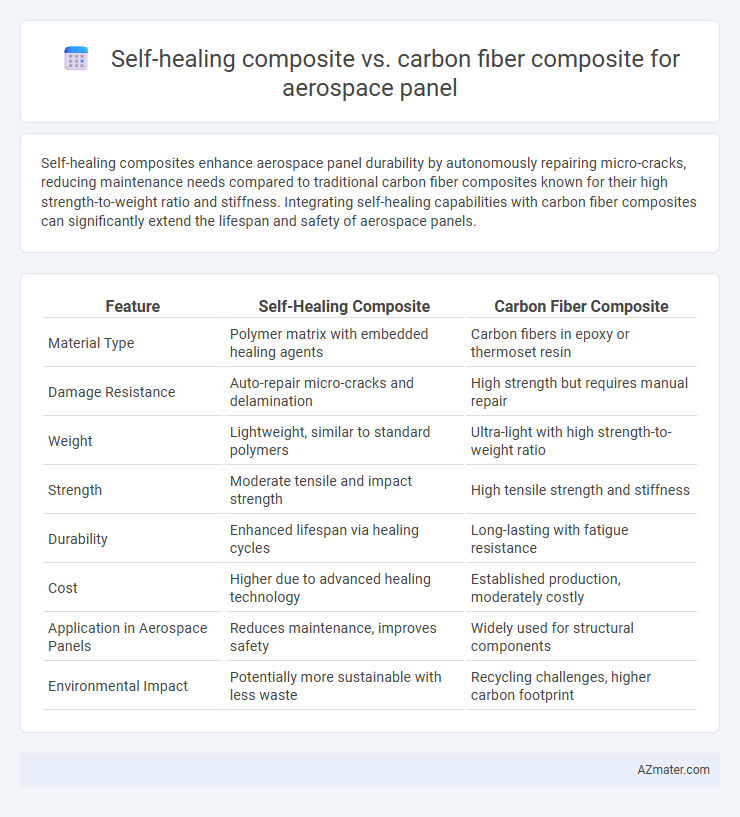Self-healing composites enhance aerospace panel durability by autonomously repairing micro-cracks, reducing maintenance needs compared to traditional carbon fiber composites known for their high strength-to-weight ratio and stiffness. Integrating self-healing capabilities with carbon fiber composites can significantly extend the lifespan and safety of aerospace panels.
Table of Comparison
| Feature | Self-Healing Composite | Carbon Fiber Composite |
|---|---|---|
| Material Type | Polymer matrix with embedded healing agents | Carbon fibers in epoxy or thermoset resin |
| Damage Resistance | Auto-repair micro-cracks and delamination | High strength but requires manual repair |
| Weight | Lightweight, similar to standard polymers | Ultra-light with high strength-to-weight ratio |
| Strength | Moderate tensile and impact strength | High tensile strength and stiffness |
| Durability | Enhanced lifespan via healing cycles | Long-lasting with fatigue resistance |
| Cost | Higher due to advanced healing technology | Established production, moderately costly |
| Application in Aerospace Panels | Reduces maintenance, improves safety | Widely used for structural components |
| Environmental Impact | Potentially more sustainable with less waste | Recycling challenges, higher carbon footprint |
Introduction to Aerospace Panel Materials
Self-healing composites offer advanced repair capabilities by autonomously restoring structural integrity, reducing maintenance costs and increasing lifespan in aerospace panels. Carbon fiber composites provide exceptional strength-to-weight ratios and high stiffness, making them the predominant choice for aerospace panel materials requiring durability and lightweight performance. Emerging trends in aerospace panel materials emphasize integrating self-healing properties within carbon fiber composites to combine structural efficiency with enhanced damage tolerance.
Overview of Self-Healing Composites
Self-healing composites incorporate microcapsules or vascular networks containing healing agents that autonomously repair damage, enhancing durability and safety in aerospace panels. These materials reduce maintenance costs and extend service life by mitigating microcracks and delamination common in traditional carbon fiber composites. Compared to carbon fiber composites, self-healing alternatives offer improved damage tolerance without compromising structural strength or weight efficiency essential for aerospace applications.
Properties of Carbon Fiber Composites
Carbon fiber composites exhibit exceptional strength-to-weight ratios, high stiffness, and excellent fatigue resistance, making them ideal for aerospace panels requiring durability and performance. Their thermal stability and corrosion resistance contribute to long-lasting structural integrity under extreme flight conditions. However, unlike self-healing composites, traditional carbon fiber materials lack the ability to autonomously repair microcracks, which can limit maintenance intervals and increase lifecycle costs.
Mechanical Performance Comparison
Self-healing composites exhibit superior damage tolerance and crack repair capabilities compared to traditional carbon fiber composites, significantly enhancing the mechanical durability of aerospace panels. Carbon fiber composites provide high stiffness-to-weight ratios and excellent tensile strength but lack intrinsic autonomic repair mechanisms, leading to compromised performance under impact or fatigue loading. The integration of self-healing polymers in composite matrices improves fracture toughness and extends service life, making them a promising alternative for aerospace structural applications where mechanical resilience and maintenance reduction are critical.
Damage Tolerance and Repairability
Self-healing composites offer enhanced damage tolerance compared to traditional carbon fiber composites by autonomously sealing micro-cracks and preventing crack propagation, thereby extending service life. Carbon fiber composites, while highly strong and lightweight, require manual inspection and complex repair techniques after impact damage, increasing maintenance time and cost. The intrinsic repairability of self-healing composites reduces aircraft downtime and maintenance expenses, making them advantageous for aerospace panels subjected to high fatigue and impact loads.
Weight and Structural Efficiency
Self-healing composites in aerospace panels offer enhanced durability by autonomously repairing micro-cracks, potentially reducing maintenance frequency while maintaining a competitive weight profile. Carbon fiber composites provide superior structural efficiency with high strength-to-weight ratios critical for aerospace applications, ensuring panel stiffness and load-bearing capacity under extreme conditions. The integration of self-healing properties into lightweight carbon fiber matrices could optimize overall panel performance by balancing structural integrity and weight reduction.
Environmental Resistance and Durability
Self-healing composites in aerospace panels offer superior environmental resistance by autonomously repairing microcracks caused by temperature fluctuations and UV radiation, extending service life under harsh conditions. Carbon fiber composites, while renowned for high strength-to-weight ratios, often require additional coatings or treatments to withstand moisture, oxidation, and abrasive environments. The intrinsic repair capabilities of self-healing composites result in enhanced durability and reduced maintenance frequency compared to traditional carbon fiber composites, especially in long-duration aerospace missions.
Cost Analysis and Manufacturing Considerations
Self-healing composites offer reduced maintenance costs by autonomously repairing micro-cracks, unlike traditional carbon fiber composites that require manual inspections and repairs, resulting in higher lifecycle expenses. Manufacturing self-healing composites involves integrating microcapsules or vascular networks, increasing initial production complexity and costs compared to established carbon fiber layup and curing processes. While carbon fiber composites benefit from mature manufacturing infrastructure and economies of scale, self-healing composites demand advanced material synthesis and quality control, influencing aerospace panel affordability and production timelines.
Future Developments and Innovations
Self-healing composites in aerospace panels promise enhanced durability through embedded microcapsules that autonomously repair matrix cracks, reducing maintenance cycles and increasing service life compared to traditional carbon fiber composites. Future innovations target integrating nanomaterials and smart sensors within self-healing matrices to enable real-time damage detection and adaptive response, optimizing structural integrity in dynamic flight environments. Advances in scalable manufacturing techniques and hybridization with carbon fiber reinforcement aim to combine self-healing capabilities with superior strength-to-weight ratios essential for next-generation aerospace applications.
Conclusion: Choosing the Optimal Composite
Self-healing composites offer enhanced durability and reduced maintenance costs for aerospace panels by autonomously repairing micro-cracks, extending service life compared to traditional carbon fiber composites. Carbon fiber composites provide superior strength-to-weight ratios and proven performance under high stress, making them ideal for load-bearing structures. Selecting the optimal composite depends on prioritizing longevity and maintenance efficiency with self-healing materials or maximizing strength and weight savings with carbon fiber composites.

Infographic: Self-healing composite vs Carbon fiber composite for Aerospace panel
 azmater.com
azmater.com